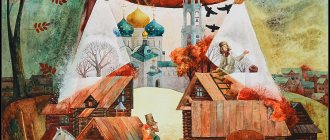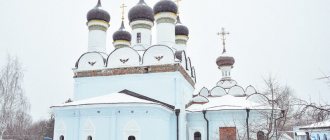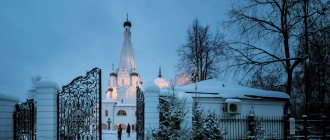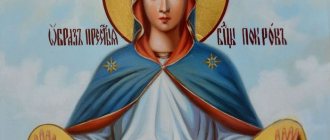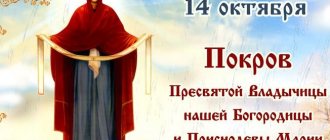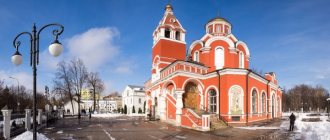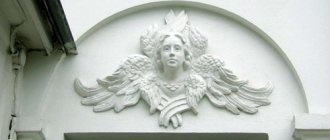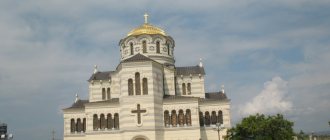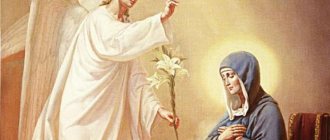"Russian" holiday
One of the favorite holidays of Orthodox Christians in Russia is the Feast of the Intercession of the Blessed Virgin Mary. The events of this holiday are connected with the history of the Byzantine Empire. On Russian soil, a large number of churches (more than 1400) are dedicated to the holiday of the Intercession. Many settlements and streets are named in his honor. For example, in the Vladimir region there is the city of Pokrov. The Icon of the Intercession of the Blessed Virgin Mary is one of the favorites in Russian Orthodoxy.
Icon of the Intercession of the Blessed Virgin Mary
However, this holiday is mentioned only in Russian monthly books. The history of this event is not (or has not been preserved) in the Byzantine chronicles. But there is a corresponding legend (in this case, “The Life of Andrei the Fool”). There is also no Byzantine iconographic image dedicated to the Intercession of the Mother of God. What is the paradox? Why are events that happened in another state still especially remembered and revered by Russians? Why is the icon of the Intercession especially loved in Russia?
What does the Mother of God pray for, what does the people ask for?
Of course, about protection from foreign enemies, from evil people, from misfortunes and diseases. After all, She covered the people with her omophorion and protected them from the enemy.
As stated above, more than 1,300 temples, churches, and cathedrals dedicated to the Intercession have been built in Russia. I would like to tell you about one temple whose architecture evokes delight. This is a church on the Nerl. It is difficult to imagine a more elegant structure. Miniature, graceful - “white swan”: that’s what people call it.
It was built by Andrei Bogolyubov in 1165 after the Volga campaign. He realized that the Mother of God was protecting Rus' by covering her with her omophorion. Carvings decorate all facades. The figures have a certain meaning. At the top is the ancestor of the clan to which the Ever-Virgin belongs - King David with a harp. There is an eagle on all sides, and lions below. The proximity of animals symbolically speaks of the harmony and peace established under the prince.
The temple is located 1.5 km from Bogolyubovo station, Vladimir region.
Feast of the Intercession of the Blessed Virgin Mary
The appearance of the Feast of the Intercession of the Most Holy Theotokos was preceded by the events described in “The Life of Andrew the Fool” (written in the 10th century). The events of the life tell about the 5th century, but there are other interpretations of this text. For example, this: during the attack of enemies on Constantinople, Christians gathered in the Blachernae Church to pray. It was here that one of the greatest shrines of the Christian world, the robe (clothing) of the Mother of God, was kept since the 5th century.
During the night service, Blessed Andrew was in the church with his disciple Epiphanius. They saw the appearance of the Mother of God. She was surrounded by angels and many saints, including John the Baptist and John the Theologian. Then the Most Holy Theotokos, having removed the omophorion (veil) from her head, spread it over the praying people. Soon the enemy retreated from Constantinople. Presumably this event occurred in 910.
Where to go to get to the Intercession Cathedral
There are many cathedrals and temples in Moscow, here are the names of some of them:
- Intercession Cathedral, Red Square.
- Church of the Intercession of the Blessed Virgin Mary in Medvedkovo, Moscow.
- Intercession Cathedral on Novokuznetskaya Street, Moscow.
- Church of the Intercession of the Blessed Virgin Mary, village of Akulovo, Moscow region. Outwardly she is not famous for anything, but many people in Russia know about her. Famous for the people who built and served in it.
In addition, there are monasteries in Moscow, for example:
- Intercession stauropegial convent.
There are no less Churches of the Intercession in St. Petersburg:
- Church of the Intercession of the Blessed Virgin Mary at the Polytechnic Institute. Consecrated on December 15, 1913 (Old Art.). It was closed from 1923 to 1993. On April 10, 1995, the temple was consecrated.
- Church of the Intercession of the Blessed Virgin Mary in Nevsky Forest Park, St. Petersburg, Vsevolozhsk district.
- Church of the Intercession of the Blessed Virgin Mary on Borovaya, 1891-1893. Now this is the courtyard of the Anthony-Dymsky Monastery and others.
Church of the Intercession of the Blessed Virgin Mary in Nevsky Forest Park, St. Petersburg.
A recreated unique monument of church architecture. Old Russian wooden architecture of the 18th century. Some icons and churches of the Intercession of other cities:
- Icon of the Church of the Intercession in the village of Selezneva, Spas-Klepikovsky district, Ryazan region, 18th century.
- Icon of the Intercession of the Butyrskaya Temple, XIX century.
Most of the ancient icons, except for the cathedrals and churches of Moscow and St. Petersburg, are the property of the Tretyakov Gallery in Moscow and the Russian Museum of St. Petersburg.
So you need to go to the capitals to pray for help. Although almost every city has a Church of the Intercession.
Pokrov in Rus'
In the Russian Orthodox Church, the Feast of the Intercession of the Blessed Virgin Mary is celebrated on October 14 according to the new style. The veneration of this holiday in Rus' began under the holy prince Andrei Bogolyubsky (1111-1174). Initially, this day began to be celebrated in the Vladimir-Suzdal lands. The prince built the Church of the Intercession on the Nerl (Bogolyubovo, Vladimir region). Over time, the Intercession of the Mother of God became one of the most beloved holidays of the Russian people. Moreover, for Orthodox Christians the main thing was no longer the motive of delivering the Byzantine Empire from enemy attack. The believing soul responded to the example of the intercession of the Mother of God of the Orthodox, the invisible grace-filled prayer protection.
“We believe in our hearts that the Most Holy Theotokos always prays for the Christian race and intercedes for it before Her Divine Son. But Blessed Andrei and Epiphanius were convinced of this with their own human eyes. When She descended from under the arches of the temple into the altar and prayed for a long time, kneeling. Let us remember that the Apostle Paul calls the devil the prince of the power of the air. And then, with great gratitude to Her and Her Divine Son, we will understand the meaning of Her Cover, shining with the Divine light, spread over the heads of those praying, with which She protected them from the prince of darkness flying low in the air and his dark angels, whom She struck with the lightning of her prayers sparkling from Her Intercession.
You see how great and holy the significance of the Feast of the Intercession of the Most Holy Theotokos is for us. How the vision of blessed Andrew and Epiphanius strengthens our faith in Her as the Diligent Intercessor of our peace” (St. Luke of Crimea, 1877-1961).
The image of the Virgin Mary in Russian painting
Russian painters in their paintings followed the types of images of the Most Holy Theotokos that had developed in icon painting, introducing their own vision into them. The Russian Orthodox Church has up to 260 icons of the Mother of God, glorified by various miracles. Among the Mother of God icons, six main iconographic types can be distinguished:
- “Tenderness” (Mary is depicted bending towards the Child, who pressed his cheek to her cheek)
- “Hodegetria”, or “Guide” (Mary with the posture of an empress, the Child sits in her arms, as if on a throne)
- "Mammal Nurse (Mary Breastfeeding the Child)"
- “Leaping” (the moment of mutual caressing of Mother and Baby is captured)
- "Oranta" (Our Lady with hands raised in prayer)
- “The Sign” (The Mother of God in the pose of Oranta, on the chest there is a medallion with the image of Jesus Christ).
The remaining icons are a kind of edition of the main types or, as the icon painters said, an adaptation. The formation of an iconographic type is a complex process, conditioned by the entire cultural and historical situation. But the entry of a new image into the history of the Orthodox tradition is always associated with a miracle - the appearance of an icon. Such icons worked miracles and healings; they were revered, loved and called miraculous. They were taken as a sample, from which countless repetitions were made.
The most revered and oldest Russian icon is the Mother of God of Vladimir. The first mention of it occurs in the chronicle in 1155. From sources it is known that she was brought from Constantinople to Kyiv and was in Vyshgorod in a convent. In 1155, Prince Andrei Bogolyubsky took the icon to his new principality of Vladimir. The glorification of the icon is associated specifically with ancient Vladimir. “Vladimirskaya” became the prototype for many Russian versions of “Tenderness” associated with locally revered miraculous icons (Our Lady of Don, Our Lady of Igorevsk, Our Lady of Fedorov).
Sources of reproductions: Religious subjects in Russian painting, etnaa, St. Isaac's Cathedral, Art-catalog, Artsait, White City, Russian religious painting, Yakov Krotov Library
Protection of the Virgin Mary. Nesterov Mikhail Vasilievich. 1911 Painting of the concha of the apse of the Church of the Intercession of the Virgin Mary of the Marfo-Mariinsky monastery Intercession Church of the Marfo-Mariinsky monastery
Protection of the Mother of God. Nesterov Mikhail Vasilievich. 1914 Wood, oil. 91x63. State Tretyakov Gallery, Moscow
Receipt in 1995 from Z. V. Nortsova according to the will of P. M. Nortsov from the collection of P. M. Nortsov and Z. V. Nortsova, Moscow
Our Lady. Argunov Ivan Petrovich. 1753 (?). Canvas, oil. 202x70.7 Copy of the Groot icon, 1749. From the Resurrection Monastery, New Jerusalem. State Russian Museum, St. Petersburg
Mother of God. Vishnyakov Ivan Yakovlevich. Icon of St. Andrew's Church in Kyiv
Virgin and Child. Kiprensky Orest Adamovich. Between 1806 and 1809 Pressed cardboard, oil. 168x85. Icon from the northern gate of the main iconostasis of the Kazan Cathedral in St. Petersburg. State Russian Museum, St. Petersburg
The exact time of creation of “The Virgin and Child” is unknown. The icon was commissioned by the Kiprensky Council of the Academy of Arts for the Kazan Church, later the Kazan Cathedral, being built in St. Petersburg. In June 1806, the Council approved the artists’ sketches, including a sketch for the image of the “Our Lady”. Kiprensky was given one hundred rubles for it, and in September of the same year the Council decided: “Pensioner Kiprensky, in addition to the 100 rubles previously given, will be given 50 rubles with a receipt in addition to the previously given 100 rubles.” More than two years later, in February 1809, Kiprensky left St. Petersburg for Moscow. This date determines the lower limit of the period of work on the icon, since Kiprensky returned to St. Petersburg after completing the interior decoration of the temple.
The image of the Mother of God, in accordance with the fashion of that time, was painted according to Western European models, Russian icon traditions are completely ignored. This is no longer the Orthodox Mother of God, but the Catholic Madonna.
During the alterations in the Kazan Cathedral in 1836, Kiprensky’s work was moved from the third iconostasis to the northern gate of the main entrance (Aplaksin A. Kazan Cathedral in St. Petersburg. 1811-1911. - St. Petersburg, 1911. P. 68, 73.). In 1932, during the closure of the temple, the image was transferred to the Russian Museum as the work of an unknown artist and was identified in 1952 during the re-inventory of the museum's collection of paintings. Russian general education portal
Our Lady. Vladimir Lukich Borovikovsky. 1814–1815 Canvas, oil. 144x71. Icon on a plot from the Apocalypse. State Tretyakov Gallery, Moscow
The Virgin and Child in a host of angels. Borovikovsky Vladimir Lukich. 1823 Oil on canvas. 35x25.5. State Russian Museum, St. Petersburg
Virgin and Child. Borovikovsky Vladimir Lukich. Copper, oil. 45.3×36. State Tretyakov Gallery, Moscow
The Virgin Mary. Varnek Alexander Grigorievich. 1815 State Russian Museum, St. Petersburg
Our Lady. Varnek Alexander Grigorievich State Russian Museum, St. Petersburg
Virgin and Child. Vigi Anton Karlovich. Circa 1822 Icon from the Church of St. Nicholas Elagin Palace in St. Petersburg. State Russian Museum, St. Petersburg
Representation of Our Lady for pupils of the Smolny Institute. Venetsianov A. G. 1832-1835
The Virgin Mary with the Child Christ and John the Baptist. Egorov Alexey Egorovich. Canvas, oil. 92x62.8. State Tretyakov Gallery, Moscow
During the artist’s lifetime, contemporaries (and not only in Russia, but also in Italy) gave the highest assessment of his talent, calling him “the Russian Raphael.” After graduating from the Academy of Arts, he traveled to Italy, where he amazed and sometimes embarrassed Italian artists with his talent. Pope Pius VII himself persuades him to remain in Italy as a court painter. However, Alexey Egorov returns to Russia, where fame, hard work as a painter and teacher (among his students are F.A. Bruni, K.P. Bryullov, A.A. Ivanov, etc.), well-deserved awards and titles await him. He is a typical representative of Russian high classicism, paints portraits, takes an active part in painting churches and cathedrals in St. Petersburg and its suburbs, Georgia, and Poland. But it was precisely the painting of images for churches in St. Petersburg and Tsarskoe Selo that displeased Emperor Nicholas I. A. E. Egorov was removed from teaching, despite the artist’s protection by the Council of the Academy of Arts. However, even the luminaries of Russian painting continued to turn to the artist for advice. Yes, and he worked on the paintings of A.E. Egorov until his last days.
The Virgin and Child. Egorov Alexey Egorovich
Madonna Alba. Bruni Fedor Antonovich. 1837 Copy from a painting by Raphael
Virgin and Child. Bruni Fedor Antonovich. 1840-1850s State Russian Museum, St. Petersburg
Virgin and Child in Roses. Bruni Fedor Antonovich. 1843 Oil on canvas. 64.7x40 State Tretyakov Gallery, Moscow
Virgin and Child. Bruni Fedor Antonovich. 1858 Oil on canvas. 63x46.7. Ivanovo Association of Art Museums
Virgin and Child. Maksimov Alexey Maksimovich. 1846 Oil on canvas. 227x125. State Tretyakov Gallery, Moscow
Virgin and Child. Markov Alexey Tarasovich. 1849
Our Lady. Scotty Mikhail Ivanovich. 1849 Oil on canvas. State Russian Museum, St. Petersburg
Our Lady. Neff Timofey Andreevich. Oil on canvas, 59x40. State Russian Museum, St. Petersburg
Our Lady. Kapkov Yakov Fedorovich. 1853 Oil on canvas. Far Eastern Art Museum
Virgin and Child. Vrubel Mikhail Alexandrovich. 1884–1885
Virgin and Child. Vrubel Mikhail Alexandrovich. 1885 Painting of the St. Cyril Church in Kyiv
The Virgin and Child. Vasnetsov Viktor Mikhailovich. Early 1880s. Sketch of the painting of the Vladimir Cathedral in Kyiv State Tretyakov Gallery, Moscow
The Virgin and Child on the throne. Vasnetsov Viktor Mikhailovich. 1885–1893 Sketch of the painting of the Vladimir Cathedral in Kyiv State Tretyakov Gallery, Moscow
Virgin and Child. Vasnetsov Viktor Mikhailovich. Fragment of the painting of the Vladimir Cathedral in Kyiv Vladimir Cathedral, Kyiv
Apse of the Altar with the figure of the Virgin and Child. Victor Mikhailovich Vasnetsov. Sketch of the painting of the Vladimir Cathedral in Kyiv
Our Lady Hodegetria. Victor Mikhailovich Vasnetsov. 1899 Sketch for the altar mosaic of the Church of Mary Magdalene in Darmstadt
Virgin and Child. Vasnetsov Viktor Mikhailovich. 1901 Oil on canvas. 209x88. Original for the mosaic of the Church of the Resurrection of Christ. State Russian Museum, St. Petersburg
Virgin and Child. Repin Ilya Efimovich. 1896 Zinc, oil. 101x62.5 Vitebsk Art Museum
Our Lady. Bruni Nikolai Alexandrovich. 1900 Oil on canvas. 118x93.5. Original for the mosaic of the Church of the Resurrection of Christ. State Russian Museum, St. Petersburg
The Virgin and Child. Nesterov Mikhail Vasilievich. 1890 Private collection
Our Lady. Nesterov Mikhail Vasilievich. 1899 Wood, oil. 66.7x30.7 Nizhny Novgorod Art Museum
Our Lady and Saint John. Nesterov Mikhail Vasilievich. Sketch. 1899 Oil on canvas. 91.5x73 Nizhny Novgorod Art Museum
Virgin and Child. Nesterov Mikhail Vasilievich. Second.p. 1890s - first era 1900s Paper, watercolor. Sketch of the painting of the iconostasis of the Vladimir Cathedral. Private collection
Our Lady. Nesterov Mikhail Vasilievich. 1900-1910s. Canvas on cardboard, oil. 28x16.5 Private collection
Our Lady of Tenderness. M. V. Nesterov. 1906 Rybinsk State Historical, Architectural and Art Museum-Reserve
Our Lady of Tenderness. Nesterov Mikhail Vasilievich. 1909 Copper, oil. Image of the iconostasis of the Church of the Intercession of the Virgin Mary of the Marfo-Mariinsky Monastery. Intercession Church of the Marfo-Mariinsky Convent
Our Lady of the Sign. Nesterov Mikhail Vasilievich. Mosaic of the eastern facade of the Church of the Intercession of the Virgin. Intercession Church of the Marfo-Mariinsky Convent
Appearance of the Mother of God. Nesterov Mikhail Vasilievich. 1910s. Canvas, oil. 80x56. Private collection
Our Lady of Tenderness of Evil Hearts. Petrov-Vodkin Kuzma Sergeevich. 1914–1915 Canvas on wood, oil. 100.2x110. State Russian Museum, St. Petersburg
With her hands raised in eternal prayer to the Lord for sinful humanity, the Mother of God appears in the painting by Petrov-Vodkin. Behind Her, in the blue sky, visions of Her earthly life appear. On the left, as a reminder of Her great destiny - She Herself with the Infant Christ in her arms, on the other side - the Savior crucified on the cross, as an echo of the great suffering of the Mother of the Son of God.
In Russian religious art there is a very large iconography of the Mother of God, but Petrov-Vodkin does not copy any famous image, but rather creates his own original iconographic type, which he called “Our Lady of Tenderness of Evil Hearts,” which still has some similarities with the ancient image of Oranta - praying Mother of God.
As a religious person and artist, Petrov-Vodkin was interested in the problem of creating a modern icon. In this regard, the canvas “Our Lady of Tenderness of Evil Hearts” (1914-1915) was created, which was conceived by the master as an icon, but was exhibited at exhibitions as an easel work. Russian Museum. Virtual course of Russian art
Virgin and Child. Petrov-Vodkin Kuzma Sergeevich. State Russian Museum, St. Petersburg Museums of Russia
Petrograd Madonna. 1918 Petrov-Vodkin K. S. 1920 Oil on canvas. State Tretyakov Gallery, Moscow
During the difficult, hungry years of 1917–1918 in Petrograd, Kuzma Petrov-Vodkin painted an image of the Mother of God, which he called the “Petrograd Madonna.” It embodied both the simple, austere coloring of Giotto’s early frescoes and the inquiring eyes of ancient Novgorod icons.
Outside the window is Petrograd, shopping arcades on Nevsky, covered with leaflets, queues for bread, in which representatives of all classes are written with precise light touches of the brush. They are collected in small groups, united by small plots, as in the hallmarks of hagiographic icons.
In this picture, the artist uses his ability to depict space in order to create a feeling of instability of the entire surrounding world - it tilts like the deck of a ship, and only the image of the Mother of God remains unchanged, unshakable, despite the upheavals of the world: the lines describing her head, the soft tilt towards to the baby, looking at us. Fine art and photography
Icon of the Intercession of the Blessed Virgin Mary: iconography
There are 2 main variants of the iconographic image of the Feast of the Intercession of the Mother of God: Suzdal and Novgorod.
In the Suzdal version, the Most Holy Theotokos stands in front of the temple and extends her omophorion over the praying people. An example of this icon painting type is the temple image of the Pokrovsky Suzdal Monastery (14th century). Now the icon is kept in the State Tretyakov Gallery.
In the Novgorod version, the omophorion is held by angels, and the Mother of God stands inside the church. This writing is typical for the image from the Zverin Monastery (1399), stored in the Novgorod Museum.
Common to both options is the image in the lower part of the icon of the eyewitnesses of the Blachernae miracle, St. Andrew the Fool and his disciple. The cover stretching over the praying people can be white or red.
Veneration of Our Lady
In the Orthodox Church, the Blessed Virgin Mary is not deified. She is by nature the same person as we all are. But She is the Mother of Jesus Christ, and He is Her Son. What could be closer than such a relationship? Every believer is spiritually united with Christ at Baptism. Who, at the Crucifixion, called the Mother of God the Mother of the Apostle John the Theologian, and, consequently, of all believers in the Savior. Therefore, every Christian is spiritually connected with the Mother of God. Christians resort to Her for help, believing in Her intercession before the throne of the Most High. People's love for the Mother of God was expressed in the construction of numerous churches in Her honor and in the painting of a large number of icons.
“The Mother of God by grace is the Mother of the whole world, especially the Christian world. Christ called all those who believed in Him his brothers and sisters. Therefore, the Mother of God became at the same time our Mother. Throughout our entire life's journey, She remains our constant leader to Christ the Savior. If all the saints intercede for us as for brothers, then the Blessed Virgin intercedes for us as for children. If all the saints beg for us as servants of God, then the Most Pure Virgin asks as the Mother of God. The saints beseech God as the Father, the Most Holy Virgin as the Son” (Priest Konstantin Zagorodnov).
The meaning of the holiday of Intercession
The very name of the holiday - the Intercession of the Blessed Virgin Mary - reveals its meaning. This is the complete trust of believers in the Mother of God and Her protection. Since the time of the Baptism of Rus', Orthodox Christians have associated hopes for salvation in hopeless situations with the name of the Mother of God. The icon of the Protection of the Most Holy Theotokos precisely means that believers place all their hope in the maternal intercession of the Queen of Heaven. To Her, as the only hope, prayers were and are being directed for help in protecting the Russian land from enemies. They call upon her to support her in various life situations when there is no strength or ability to withstand adversity.
“The cover of the Mother of God is precisely evidence that all our troubles, even if they sometimes occur from our obstinacy and riotousness, are still a sign that God does not abandon us, moves us to repentance, and guides us on the path of righteousness. And the Mother of God, interceding for us, spreading the Veil of Her goodness over us, is a faithful evangelist that the wrath of God is soon ready to be replaced by mercy in the event of our sincere and effective repentance” (priest Dimitry Shishkin).
Icon of the Intercession of the Blessed Virgin Mary - what it helps with
How does the icon of the Intercession of the Mother of God help? In front of this image, believers pray for health, for solving material problems, and resolving conflict situations. The Most Holy Theotokos with her cover protects and protects from enemies.
“She, like a mother, protects us, her children, swaddling us in her prayers. All we can do is resort to Her cover more often, and not think that She can disdain us. She probably finds it unpleasant to look at our sins. She is still like a mother who sees that the child is dirty, cleanses with love, admonishes, kisses, presses to her heart and bless. It is very important to maintain this trust in Her as a loving mother. And seek help in the most difficult and difficult life situations. And share the joy, of course. The task of every Christian on this day is to feel this great gift that we have – Her protection” (hieromonk Kirill Zinkovsky).
Holiday traditions
In Rus' it was believed that the Intercession comes when autumn recedes. In this regard, there was a proverb: “Before lunch on Intercession it is autumn, and after lunch it is already winter.”
It was on Pokrov that the first snow could fall: large with flakes or fine drizzle.
Other signs that people believed in during the Intercession:
- With the onset of the holiday, the villagers were actively preparing for winter: preparing feed for livestock, insulating their homes
- On Pokrov it is customary to bake pancakes; they are a symbol of the sun, and therefore grace in the house
- On Intercession Day the huts began to be heated. People believed that the Holy Fire would warm not only the hut, but also the heart and soul
- All field work on Pokrov should have already been completed
- The house on Pokrov should be clean, the table should be set and dishes from the new harvest should be prepared.
- On Pokrov, the oldest women could perform a ritual of protection against childhood diseases. To do this, each child was doused with water from a sieve or sieve, pronouncing about the baby’s health.
Weddings on Pokrov
Unmarried girls and unmarried guys felt special on Pokrov Day. All the free girls were really looking forward to this holiday in order to tell fortunes for their betrothed.
If there is a lot of snow on Pokrov, it means there will be a lot of weddings next year. Free girls, coming to church, asked the Most Holy Theotokos for a good groom.
Dressing up on this day for unmarried people is a special procedure; the brighter and more beautiful the girl, the faster she will find a groom.
Cover for the military
For those who defend their homeland, Intercession Day is not an ordinary holiday. The military believed that it was the Most Holy Theotokos who protected them and helped them win difficult battles. Our Lady of the Intercession is considered the protector of the Zaporozhye Cossacks.
Everyone knows that the Most Holy Theotokos helped Russian troops defeat the Turkish army in 1552, after which Kazan was captured. In connection with these events, Ivan the Terrible ordered the construction of a temple in honor of the Intercession of the Holy Mother of God.
This temple still stands today, its location is Red Square, Moscow, St. Basil's Cathedral.
Icon of the Protection of the Blessed Virgin Mary: prayers
Oh, Most Holy Virgin, Mother of the Lord of the highest powers, Heaven and earth Queen, our city and country, Almighty Intercessor! Accept this song of praise and thanksgiving from us, Thy unworthy servants, and lift up our prayers to the Throne of God of Thy Son, that He may be merciful to our iniquities, and add His grace to those who honor Your all-honorable name and with faith and love those who worship Your miraculous image.
For we are not worthy of mercy from Him, unless You propitiate Him for us, O Lady, for all things are possible for You from Him. For this reason we resort to You, as to our undoubted and speedy Intercessor: hear us praying to You, overshadow us with Your all-powerful protection, and ask God for Your Son: to be our shepherd We give zeal and vigilance for souls, the city ruler wisdom and strength, we judge truth and impartiality , a mentor is reason and humility, a spouse is love and harmony, a child is obedience, patience to those who are offended, fear of God to those who are offended, complacency to those who mourn, abstinence to those who rejoice, but to all of us the spirit of reason and piety, spirit mercy and meekness, the spirit of purity and truth.
To her, Most Holy Lady, have mercy on Your weak people; Gather those who are scattered, guide those who have gone astray, support old age, bring up young chastity, raise children, and look upon us all with the gaze of your merciful intercession, raise us up from the depths of sin and enlighten us Our heart's eyes are to the sight of salvation, be merciful to us here and there, in the land of earthly coming and at the terrible judgment of Your Son; Having ceased in faith and repentance from this life, our fathers and brothers created eternal life with the Angels and with all the saints.
For you are, Lady, the Glory of Heaven and the Hope of the earth, You, according to God, are our Hope and Intercessor of all who flow to You with faith. We pray to You, and to You, as the Almighty Helper, we commit ourselves and each other and our whole life, now and ever and unto the ages of ages. Amen.
